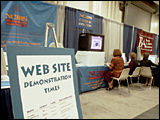INTERNET REVOLUTIONIZES CRIME DATA
New Access for Professionals and Laymen Alike
November 12, 1998
By Hoag Levins

|
|
Photo: Hoag Levins
The National Criminal Justice Reference Service 'Cyber Booth' display.
|
|
WASHINGTON, D.C. (APBnews.com) -- The conference of the American Criminology Society (ASC) has experienced a number of major changes in recent years but none as dramatic as that wrought by the Internet, according to the information vendors who play a major role in the 50-year-old annual event.
The ASC national meeting -- the world's largest such gathering -- has long included a central trade show of book publishers and government agencies that specialize in crime-related information products.
This year's five-day event, which has drawn 3,000 scholars, researchers and other experts to the Marriott Wardman Park Hotel, has a trade show floor that looks like a cross between a book store and a cyber cafe.
For instance, the largest section of the National Criminal Justice Reference Service display is called the "Cyber Booth," with Web site demonstrations scheduled throughout the day. Among other things, the site offers a free database of more than 1,000 government and private programs designed to prevent or combat family and community violence. On Thursday a steady stream of ASC attendees stopped by to check it out.

|
|
Photo: Hoag Levins
Frank Mortimer, Jr., of Prentis Hall.
|
|
High level of criminologist interest
Elsewhere around the hall, other attendees gathered to hear publishers explain new kinds of hybrid criminology reference products featuring print and online components.
"The interest is really pronounced," said Frank Mortimer, Jr., the senior manager of new media for Prentice Hall, a division of Simon & Schuster. "While there's a lot of Web-related activity across all the disciplines for which we publish books, the criminal justice area is one of the most intense. People involved with criminal justice matters just seem particularly attuned to the idea of accessing and using electronic resources."
Mortimer said sales in Web-related teaching tools has skyrocketed among ASC's teaching members in the last 18 months. "We think the use of the Web in the classroom has proven so effective a tool that instructors feel they must keep pace with Internet," he said.

|
|
Photo: Hoag Levins
Cathy Anderson: 'A revolution' in criminal justice publishing.
|
|
A true 'revolution'
Cathy Anderson, editor of Copperhouse Publishing of Incline, Nev., agrees. "The changes we've seen around the ASC show during the last two years have been so great that you can accurately characterize them as a revolution," she said.
Like other publishers here, Copperhouse wants to reach the professors who select texts that will be used in courses at community colleges and universities across the country.
"The new big thing this year is Web-based 'distance learning,' " Andersen explained. "One of our authors is starting a distance-learning course based on one of our criminology books and telling students how they can learn the subject through their computers without having to physically attend lectures."
Crime data for everyman
Other vendors noted how the Internet was eroding the wall that that used to separate "professional" crime data specialists from everyone else.
"The Web is having a tremendous impact on the way people physically access criminal justice information as well as the kinds of people who do this," said Christopher S. Dunn, senior research associate of the Inter-University Consortium of Political and Social Research (ICPSR). The University of Michigan group processes government criminal justice data into universal formats that can be accessed over the Internet, downloaded and easily manipulated with any PC.
The free service, which is funded with grants from a variety of federal justice agencies, offers Bureau of Justice Statistics (BJS) data sets, including information compiled for the annual FBI Uniform Crime Report, the National Crime Victimization Survey and corrections-reporting programs.
Online rush of curious citizens
"At our Web site, we're seeing a rush of curious nonprofessionals who are interested in crime statistics," said Dunn. "About half of our downloads ... go to AOL.com and other domains mostly used by private-citizen Web surfers. We have a lot of users who access the data to write high school reports or prepare for a class debate or research a crime-related trend for other reasons."
"Before the Internet, it was technically very difficult to get this information -- access was limited to professionals who had to have all kinds of sophisticated software and hardware to use the data on their computers," said Dunn. "But now, anyone with a browser can access the same thing. It's becoming suprisingly popular."
Hoag Levins is the managing editor of APBnews.com.
© 1998 APBnews.com
.
| 
